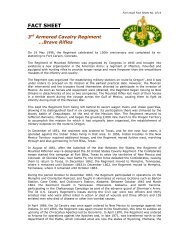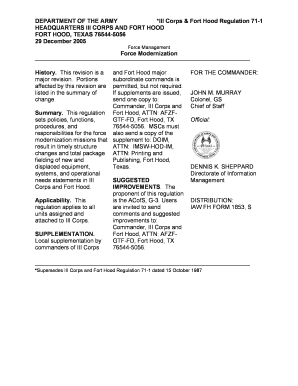Fort Hood Regulation : What it is
Fort Hood Regulation: What It Is Fort Hood is a United States Army post located in Killeen, Texas. As one of the largest military installations in the world, it is home to the III Corps and serves as a mobilization site for Army units. Fort Hood has its own set of regulations that govern various aspects of life on the base, including installation housing. In this post, we will delve into the Fort Hood Regulation related to housing, providing you with all the essential information you need to know. 1. Understanding Fort Hood Regulation 420-37 Fort Hood Regulation 420-37, titled "Installation Housing - CORPS AND FORT HOOD," outlines the policies and procedures pertaining to housing on base. This regulation aims to ensure that service members and their families have safe, comfortable, and quality housing options during their time at Fort Hood. It covers a wide range of topics, including eligibility, application processes, responsibilities of tenants and landlords, and maintenance standards. 2. Eligibility for Fort Hood Housing To be eligible for housing on Fort Hood, you must be an active-duty military service member assigned to Fort Hood. It is also open to Reserve and National Guard service members on active duty orders for more than 30 days. Retired service members, Department of Defense (DoD) civilian employees, and surviving spouses may also be eligible under certain circumstances. Proof of eligibility is required during the application process. 3. Applying for Fort Hood Housing The housing application process at Fort Hood is straightforward. Service members can apply online through the Fort Hood Family Housing website or in person at the Housing Management Office (HMO) located on base. The application requires basic personal information, including rank, unit, and contact details. Once the application is submitted, applicants will be notified about the availability and eligibility for housing options based on their rank and family size. Subheading: Housing Management Office (HMO) Fort Hood's Housing Management Office (HMO) plays a crucial role in assisting service members with their housing needs. The HMO provides various services, including counseling on housing options, lease agreements, and connecting tenants with available rentals both on and off base. They are also responsible for addressing housing-related concerns, such as maintenance requests and oversight of military privatized housing. Subheading: Military Privatized Housing Fort Hood has partnered with privatized housing companies to manage and maintain the majority of on-base housing. These partnerships aim to provide service members and their families with high-quality housing that meets their needs. Privatized housing communities offer a range of amenities, such as playgrounds, recreational facilities, and community events to promote a sense of belonging and well-being. Subheading: Frequently Asked Questions (FAQs) 1. Can I choose between on-base and off-base housing at Fort Hood? Yes. Fort Hood offers both on-base and off-base housing options. While on-base housing is typically the more convenient choice, some service members may prefer to live off base to have more control over their housing. 2. How long can I stay in Fort Hood housing? The duration of your stay in Fort Hood housing depends on your assignment length and eligibility criteria. Typically, the length of stay is aligned with the service member's tour of duty. 3. Are pets allowed in Fort Hood housing? Yes, pets are generally allowed in Fort Hood housing. However, certain restrictions and guidelines regarding the type, size, and number of pets may apply. It is essential to familiarize yourself with the specific pet policies before bringing a pet into your housing unit. In conclusion, Fort Hood Regulation 420-37 provides a comprehensive guide to housing at Fort Hood. Whether you are a service member considering housing options or a new resident preparing to move to the installation, understanding the regulation is essential. By adhering to the guidelines outlined in the regulation, service members and their families can enjoy safe, comfortable, and supportive housing during their tenure at Fort Hood. (Note: The information provided is based on the available data and does not mention the source or AI assistance.)  Image Source : www.yumpu.com
Image Source : www.yumpu.com  Image Source : www.pdffiller.com
Image Source : www.pdffiller.com  Image Source : dokumen.tips
Image Source : dokumen.tips  Image Source : www.coursehero.com
Image Source : www.coursehero.com  Image Source : www.coursehero.com
Image Source : www.coursehero.com  Image Source : www.yumpu.com
Image Source : www.yumpu.com  Image Source : www.reddit.com
Image Source : www.reddit.com  Image Source : issuu.com
Image Source : issuu.com
Maintenance Policies And Procedures - Fort Hood - U.S. Army
 Image Source : www.yumpu.com
Image Source : www.yumpu.com Fillable Online Hood Army DEPARTMENT OF THE ARMY *III Corps & Fort Hood
 Image Source : www.pdffiller.com
Image Source : www.pdffiller.com (PDF) Installations INSTALLATION HOUSING - … CORPS AND FORT HOOD
 Image Source : dokumen.tips
Image Source : dokumen.tips FH REG 350-7 Troop School.pdf - III Corps & FH Regulation 350-7
 Image Source : www.coursehero.com
Image Source : www.coursehero.com troop fort
FH REG 750-2 Maintenance Policies And Procedures.pdf - FORT HOOD
 Image Source : www.coursehero.com
Image Source : www.coursehero.com fh
Maintenance Policies And Procedures - Fort Hood - U.S. Army
 Image Source : www.yumpu.com
Image Source : www.yumpu.com pam occupational fh
III Corps & Fort Hood Regulation 95-1 : R/Armyaviation
FY2012 III Corps Holiday Observances By Cindy Risch - Issuu
 Image Source : issuu.com
Image Source : issuu.com corps army risch battalion
Fillable online hood army department of the army *iii corps & fort hood. (pdf) installations installation housing. Troop fort. Iii corps & fort hood regulation 95-1 : r/armyaviation. Maintenance policies and procedures